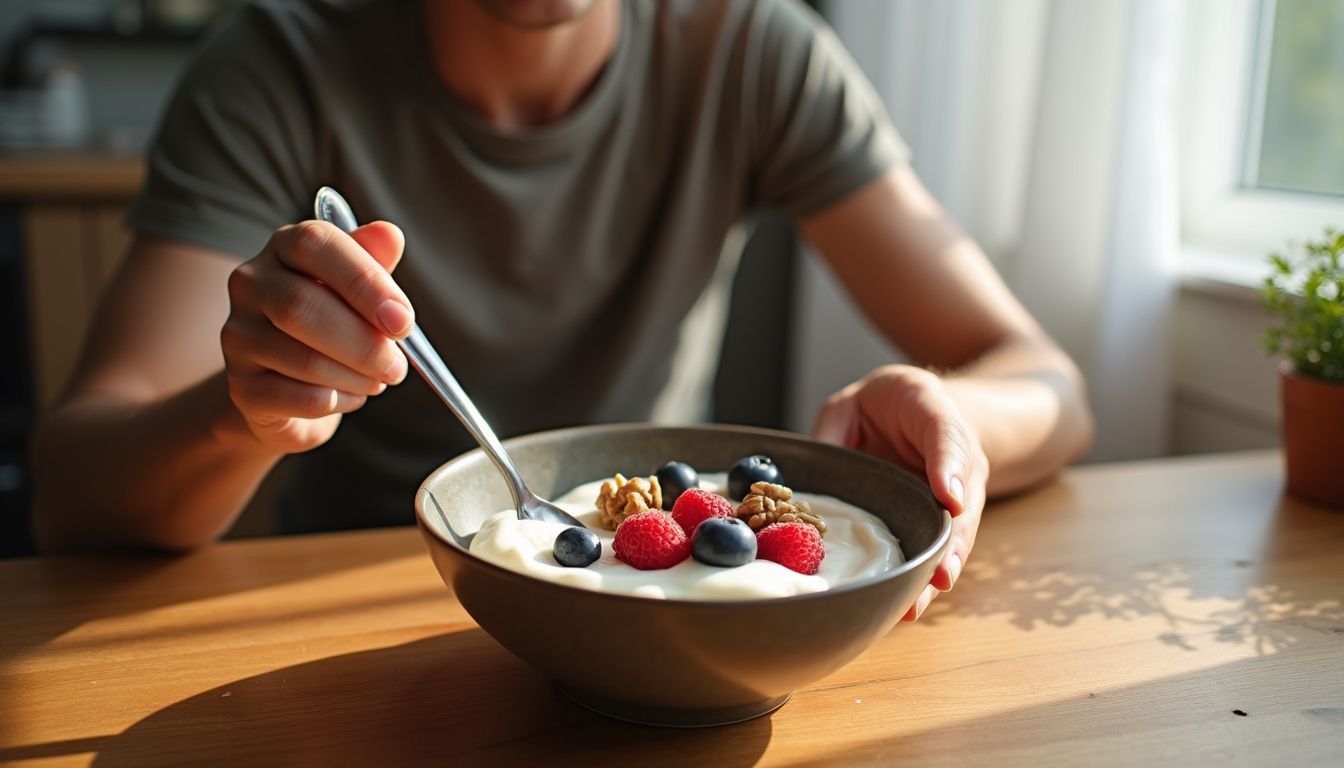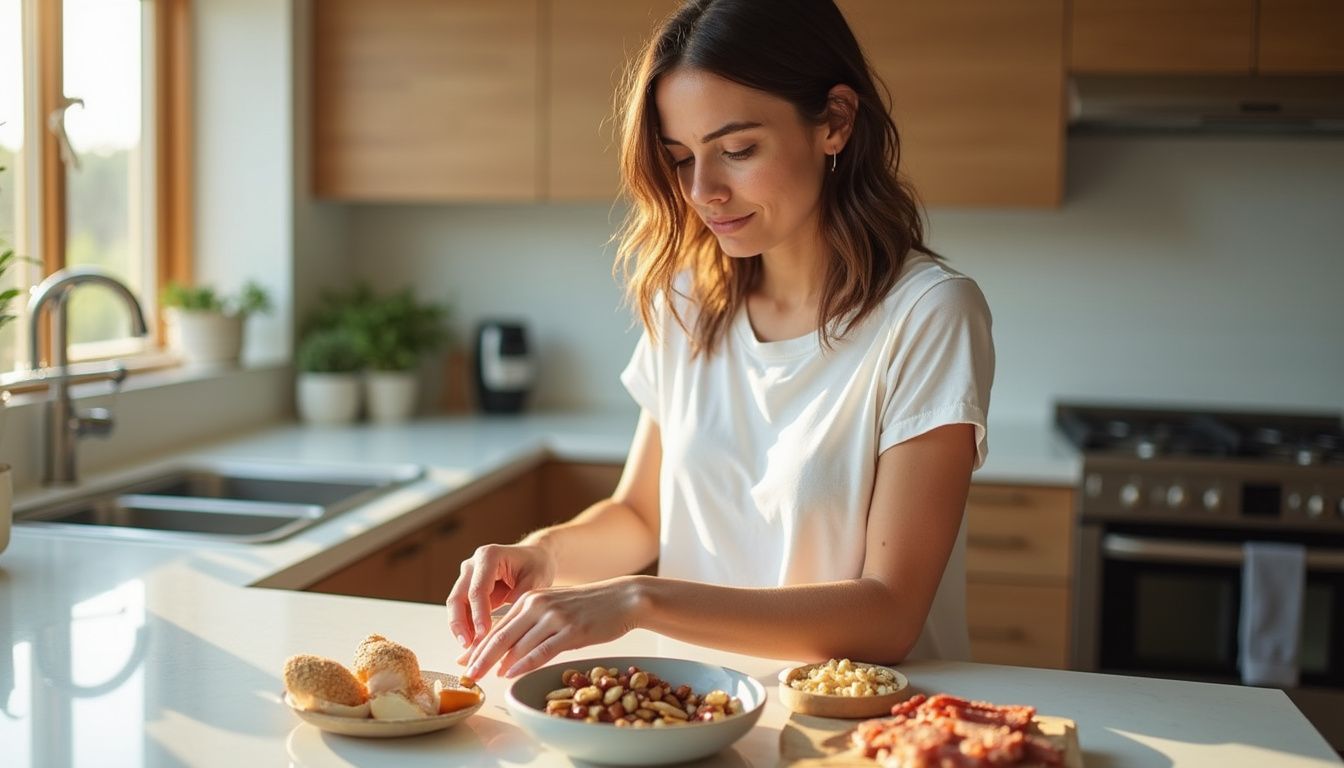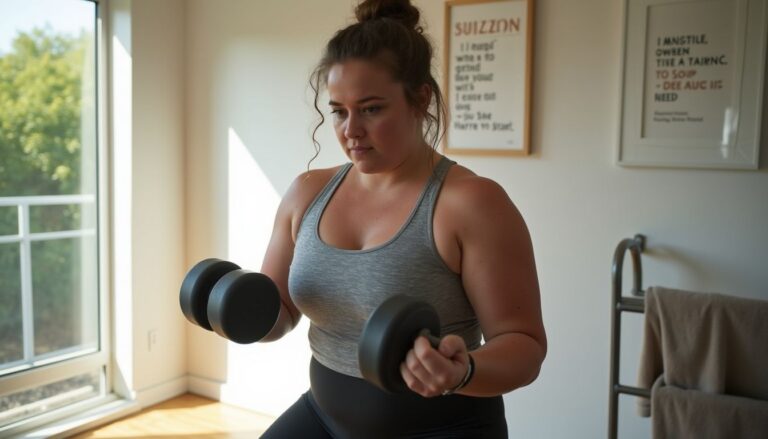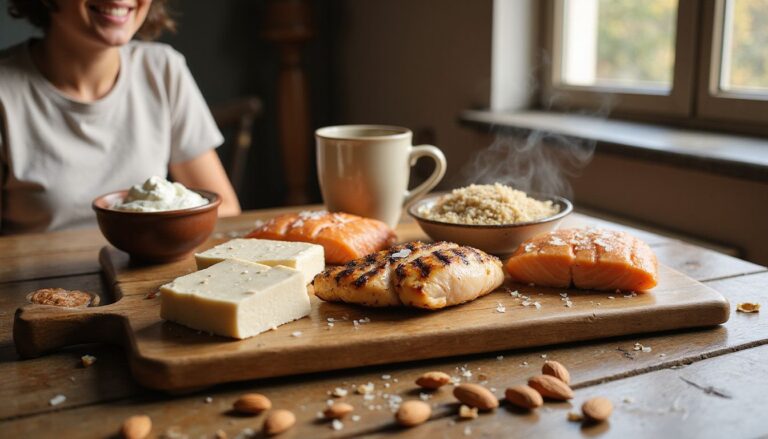Top High-Protein Snacks For Weight Loss: Best Healthy Snack Options
Our Nutrition Assistant AI Suite will transform your body. You will lose fat, get toned, and build muscle. Gain confidence and optimal health.
Choosing the best snacks for weight loss can feel tricky on busy days. High-protein snacks help tame cravings, steady blood sugar, and keep you full longer.
This guide highlights simple, nutrient-dense options you can prep fast. You will see which healthy snack choices fit your routine and support steady progress.
Key Takeaways
- High-protein snacks such as Greek yogurt, edamame, and cottage cheese provide roughly 6 to 25 grams of protein per serving, which can curb hunger.
- Picking low-calorie, nutrient-dense foods with little added sugar or unhealthy fat helps maintain muscle and steady blood sugar for better appetite control.
- Replacing processed snacks with whole foods like hard-boiled eggs or roasted chickpeas can lower total daily calorie intake based on research.
- Snacks that combine protein and fiber increase fullness, reduce energy dips, and make overeating at meals less likely.
- Limiting added sugars, as the CDC advises, lowers risk for type 2 diabetes and supports healthier snack habits.

Why Choose High-Protein Snacks for Weight Loss?

High-protein snacks can help you lose weight and feel satisfied longer. These choices also support muscle health while keeping calorie intake in check.
What are the benefits of high-protein snacks?
Protein-rich snacks keep you satisfied between meals, so they are among the best high-protein snacks for weight loss. Options like Greek yogurt, cottage cheese, hummus, or roasted chickpeas often deliver at least 6 grams of protein per serving.
These foods help regulate blood sugar and cut cravings for sugary snacks. Studies suggest that a higher protein intake can reduce total daily calories.
Low-calorie snacks that are rich in protein aid muscle maintenance during weight loss. You get steady energy and feel less hungry, which makes overeating less likely at main meals.
I noticed fewer afternoon slumps after swapping potato chips for turkey roll-ups or edamame during busy workdays.
Snacking on protein sources like hard-boiled eggs or hummus gives your body steady fuel for a packed schedule.
How does protein help with weight loss?
Protein increases satiety, which means you stay full longer and crave fewer high-calorie foods. Your body also uses more energy to digest protein than carbohydrates or fat.
This is called the thermic effect of food. It means you burn a few extra calories during digestion. For instance, a cup of cottage cheese offers about 25 grams of protein and can bridge the gap between meals.
Adding high-protein snacks helps prevent overeating at lunch or dinner. Protein protects lean muscle during weight loss, which helps maintain your metabolism so you burn more calories, even at rest.
Nutrient-dense snacks like edamame, with about 18 grams per cup, or hard-boiled eggs, make appetite control easier. On days I pick Greek yogurt over chips, I crave less sugar and eat smaller portions at dinner.
Steady protein intake supports stable blood sugar, which helps you avoid the energy crashes that lead to poor choices later in the day.
Tips for Choosing Healthy High-Protein Snacks
Smart snack choices make weight loss simpler. Reading labels helps you spot nutrient-dense foods that are lower in calories and added sugar.
How to find low-calorie, nutrient-dense snacks?
You can eat high-protein snacks that are low in calories by focusing on whole, nutrient-rich foods. These choices keep you full and support a healthy lifestyle.
- Check calories per serving to keep snacks under 300 calories. For example, 1 cup of grapes has about 100 calories.
- Choose foods high in protein; hard-boiled eggs, Greek yogurt, or 1/3 cup edamame provide about 4 to 8 grams.
- Look for fiber. Six cups of air-popped microwave popcorn provide around 6 grams of dietary fiber.
- Pair protein with fiber-rich foods, such as apple slices with peanut butter or whole-grain crackers with tuna salad, to boost fullness.
- Limit added sugars and refined grains to avoid empty calories and unhealthy fats that can stall progress.
- Add fruits or vegetables. They are naturally low in fat and offer vitamins, minerals, antioxidants, and fiber.
- Pick whole foods instead of packaged diet snacks. Whole fruit, raw vegetables, or plain Greek yogurt deliver more nutrition per calorie.
- Read labels for hidden sugar or excess saturated fat that can undermine your goals.
Keeping pre-cut veggies and single-serve nuts in the fridge made healthy snacking easier for me during busy weeks. Next, see why limiting sugar and unhealthy fats matters.
Why avoid added sugars and unhealthy fats?
After choosing low-calorie, nutrient-dense snacks, it helps to understand why added sugars and unhealthy fats work against your goals. These ingredients can raise cravings and total calorie intake fast.
- Added sugars in processed snacks spike blood sugar, increase cravings, and can lead to weight gain.
- Unhealthy fats in fried foods or candy bars can raise LDL cholesterol and cardiovascular risk.
- Many 100-calorie cookie or cracker packs rely on refined flour and offer few nutrients or fiber.
- Too much sugar or saturated fat often causes energy crashes later, which leaves you tired rather than satisfied.
- Packaged snacks are often high in sodium as well as sugar and fat, which can cause bloating and water retention.
- High sugar intake raises type 2 diabetes risk. CDC reports highlight added sugars as a key concern for teens and adults.
- Filling up on unhealthy fats crowds out nutrient-dense options like nuts or avocado that contain heart-healthy fats.
- Sugary snacks do not provide lasting fullness compared with protein options like Greek yogurt, cottage cheese, or edamame.
- Choosing whole grain crackers, beans, or other plant-based protein sources can lower calories and improve digestion due to fiber.
- Swapping candy bars for nuts or low-fat cheese with fruit helped me avoid mid-afternoon fatigue.
Cutting these ingredients lets protein and fiber lead the way, so you can keep energy steady and enjoy your food.
How to include whole, unprocessed foods in snacks?
Whole, unprocessed foods make snacks more satisfying and nutritious. They provide vitamins, minerals, fiber, and protein without excess sugar or fat.
- Pick whole fruits like apples, pears, or berries for natural fiber and fullness.
- Add raw or dry-roasted nuts and seeds, for example almonds, walnuts, chia, or sunflower, for healthy fats and protein.
- Use whole-grain bases like whole-grain crackers or toast for extra fiber and steady energy.
- Prep snacks at home so you control salt and fat. Roast chickpeas with simple spices for a high-protein bite.
- Pair veggies such as carrots, cucumber, celery, or bell pepper with dips like hummus or strained yogurt for protein and fiber.
- Include minimally processed proteins like hard-boiled eggs, cottage cheese, ricotta, or canned fish for a filling snack.
- Avoid packaged foods high in added sugars or unhealthy fats. Focus on fruits and vegetables paired with protein instead.
These steps helped me manage a sweet tooth while cutting calories. Making snacks from scratch lets you enjoy real flavor from real food.
Top High-Protein Snacks for Weight Loss
You have many high-protein snacks to support weight loss. Greek yogurt with berries gives you protein plus antioxidants in one bowl. Hard-boiled eggs are a classic snack, and eating them a few times a week can fit into a heart-healthy pattern.
Edamame offers about 18 grams of plant-based protein per cup plus fiber for fullness. Cottage cheese is a tasty option with roughly 25 grams per cup. Pair it with pineapple or watermelon for extra vitamins.
Beef jerky or beef sticks provide about 9 grams of protein per ounce. Choose lower sodium versions. Roasted chickpeas supply plant protein and crunch. Turkey roll-ups let you add veggies or cheese for more nutrients.
Tuna salad on whole-grain crackers adds omega-3 fats, fiber, and protein. Smoothies can work too. Blend fruit with Greek yogurt or silken tofu for higher protein without many calories.
Kale chips with nutritional yeast deliver fiber and plant-based vitamins. These healthy snacks can help you stay on track every day.
Greek Yogurt and Mixed Berries
Greek yogurt with mixed berries blends protein, fiber, and vitamins; it is a simple, great-tasting snack.
Why is Greek yogurt with berries a great snack?
Mixing nonfat plain Greek yogurt with berries gives you protein, antioxidants, and fiber. One cup of nonfat Greek yogurt offers about 15 to 20 grams of protein, which is more filling than regular yogurt.
Berries such as strawberries, blueberries, or raspberries add vitamins and minerals like vitamin C and potassium. The tangy yogurt pairs well with their natural sweetness.
This combo is nutrient-dense and not high in calories. Many dietitians recommend it because it reduces hunger between meals without a lot of added sugar.
How much protein and nutrients does it provide?
A half cup of nonfat Greek yogurt provides around 12 grams of protein and about 80 to 90 calories with minimal saturated fat. That makes it an easy way to boost protein without many calories.
Berries add fiber for digestion and more antioxidants. A teaspoon of sunflower seeds can add crunch and healthy fats if you want variety.
Blending one-third cup yogurt with two-thirds cup frozen blueberries produces a quick smoothie with extra minerals like calcium and potassium. It feels filling without being heavy or overly sweet.
Adding a spoonful of nuts or seeds raises flavor and protein. This helps whether you follow a plant-forward plan or a general healthy eating approach.
Hard-Boiled Eggs
Hard-boiled eggs deliver protein, vitamins, and minerals. They travel well and fit most weight loss plans.
How do hard-boiled eggs support weight loss?
Eggs help you feel full longer, which supports a lower calorie intake. Each hard-boiled egg provides about 6 grams of complete protein plus iron and zinc.
They are low in calories, roughly 70 to 80 per egg, so you get a satisfying snack without overeating. Research suggests that including eggs in a balanced diet can be heart-friendly for most people.
Eggs have almost no added sugar, which helps avoid blood sugar spikes and later crashes. I keep a few in the fridge for a quick snack between meetings.
They are more portable than many high-protein options. Adding hard-boiled eggs to your routine can control cravings and support a plan built on protein and fiber.
What are good pairings with hard-boiled eggs?
Hard-boiled eggs pair well with many nutrient-dense foods. These combos balance flavor, texture, and nutrition.
- Place slices on whole-grain toast to add fiber and minerals for a filling bite.
- Serve with raw veggies such as carrot or celery sticks to increase fiber and fullness.
- Add a tablespoon of hummus for extra protein and healthy fats.
- Season with a pinch of salt, black pepper, or paprika for more flavor without sugar.
- Combine with cherry tomatoes or cucumber for a fresh boost of vitamins.
- Chop into warm oatmeal with a dash of cinnamon for a savory breakfast protein twist.
- Pair with whole-grain crackers for crunch. Choose low-sugar varieties.
- Mix chopped egg with tuna, Greek yogurt, garlic, and pepper for a high-protein spread.
- Serve alongside edamame or roasted chickpeas for more plant-based protein.
- For travel, eat with dried apricots for a sweet, fiber-rich add-on.
- Add slices to a leafy salad with olive oil for a satisfying afternoon snack.
Apple Slices with Peanut Butter
Apple slices with peanut butter deliver protein and fiber, which creates steady energy between meals.
How does this snack combine protein and fiber?
Peanut butter brings protein and healthy fats. Apple slices, especially with the skin, provide fiber, which slows digestion and steadies blood sugar.
Harvard sources note that one tablespoon of peanut butter has about 4 grams of protein. A medium apple offers about 4 grams of fiber.
This mix balances carbohydrate, protein, and fat for steady fullness. I often pack it for work because it tastes good and keeps hunger away.
What are tips for portion control?
Apple with peanut butter is nutritious, but calories add up quickly. Simple portion habits keep the snack in your target range.
- Measure 1 to 2 tablespoons of peanut butter. You get flavor and protein without too many calories.
- Use one medium apple per serving. That is about three-fourths cup of slices.
- Pick peanut butter with no added sugar or hydrogenated oils.
- Eat slowly and pay attention to hunger cues. Stop when you feel satisfied.
- Drink water or unsweetened tea alongside to help fullness.
- Avoid dipping from the jar. Portion peanut butter on a plate first.
- Log snacks in a food diary or app to track protein and calories.
- Swap in banana slices sometimes for variety and extra potassium.
- I pre-slice apples and portion the peanut butter on Sundays, which makes grabbing a balanced snack easy.
Cottage Cheese and Fruit
Cottage cheese with fruit is protein-rich and nutrient-dense. It fits a low-calorie approach and tastes refreshing.
What are the nutritional benefits of cottage cheese?
Cottage cheese is a strong source of lean protein, with about 25 grams per cup. It helps build and preserve muscle during weight loss or low-carb phases.
Half a cup paired with cantaloupe stays around 100 calories with low saturated fat. It also supplies calcium for bone health and vitamins like B12 that help convert food into energy.
Because it is lower in carbohydrates than many dairy snacks, it works well for weight loss and low-sugar eating. You fuel muscles while keeping calories controlled.
Which fruits pair best with cottage cheese?
Choose fruits that bring fiber, vitamins, and fresh flavor to your bowl. These pairings also add texture and color.
- Pineapple adds vitamin C and juicy sweetness for a bright contrast.
- Watermelon offers hydration and light sweetness for a crisp bite.
- Berries such as blueberries or strawberries provide antioxidants and balance the creamy texture.
- Cantaloupe delivers vitamins A and C with a gentle flavor that blends well with dairy.
- Peaches add fiber and natural sugars for a classic pairing.
- Mango brings color and extra vitamins for a tropical note.
- Apple slices add crunch and slow-digesting carbs for longer fullness.
- Pear slices boost fiber and sweetness. Use ripe fruit for the best taste.
Protein and calcium from cottage cheese plus fiber from fruit make this a filling snack for weight loss.
Edamame
Edamame, young soybeans, are rich in protein and easy to prepare. They work well for quick snacking.
How much protein is in edamame?
One cup of edamame, about 155 grams, contains roughly 18 grams of protein. A smaller serving, such as one-third cup, still provides more than 8 grams of protein and about 4 grams of fiber.
Edamame is a complete plant protein, which means it supplies all essential amino acids. It is also low in saturated fat and modest in sodium per small serving.
I keep frozen pods on hand for a fast snack that beats sugary choices. They help me stay full between meals without much prep.
What are easy ways to prepare edamame?
Edamame cooks quickly and holds its nutrients well. You can change seasonings to match your taste and calorie goals.
- Steam or boil shelled or unshelled edamame for 3 to 5 minutes. Drain and cool.
- Sprinkle with sea salt and serve warm or chilled for a simple option.
- Toss with chili flakes, garlic powder, or lemon juice for bolder flavor.
- Add shelled edamame to salads or grain bowls for more protein and texture.
- Roast edamame with a little olive oil and spices until crisp for a crunchy bite.
- Mix roasted edamame into homemade trail mix with nuts and seeds.
- Blend cooked edamame into hummus to create a high-protein dip.
I often steam edamame, add chili flakes, and make it my afternoon snack. The complete protein supports weight loss goals.
Turkey Roll-Ups
Turkey roll-ups use lean deli turkey to build a protein-packed snack. They are quick to make and easy to pack.
What ingredients make up turkey roll-ups?
Turkey roll-ups are simple, portable, and satisfying. You can assemble several in minutes for busy days.
- Start with sliced turkey breast for the main protein. Two ounces provide around 12 grams of protein for fewer than 70 calories.
- Add a slice of lower fat cheese like mozzarella or Swiss for extra protein and calcium.
- Layer in vegetables such as spinach or bell pepper strips for fiber and crunch.
- Wrap with whole-grain tortillas or large lettuce leaves. Whole grains add complex carbs and fiber.
- Spread a thin layer of hummus or mustard for flavor without many calories.
- Roll tightly and slice into bite-size pieces for easy snacking.
- Prep several at once and store for grab-and-go choices.
I make a batch during weekly meal prep. It stops me from grabbing less healthy snacks when I am short on time.
Why are turkey roll-ups a satisfying snack?
Turkey and cheese deliver high-quality protein that helps you feel full longer. Vegetables add fiber and crunch for extra volume without many calories.
Using lettuce wraps cuts carbs if you prefer a lower carb option. Portioning is simple, so you can control calories with little effort.
You can customize fillings to match your taste. This flexibility keeps the snack interesting and aligned with your weight loss goals.
Roasted Chickpeas
Roasted chickpeas give you a crunchy, high-protein alternative to chips. They are easy to season and batch-cook.
What makes roasted chickpeas high in protein?
Chickpeas are a plant-based protein source. A half cup of roasted chickpeas offers about 7 grams of protein, plus fiber and complex carbohydrates for steady energy.
They are lower in unhealthy fats than many packaged snacks and still satisfy a craving for crunch. They store well, so you can keep a container for quick snacking.
Adding roasted chickpeas to your routine provides convenience and solid nutrition. If you want variety, try new seasonings.
What flavor variations can you try?
Seasonings transform roasted chickpeas into many flavor profiles. You can keep calories in check while adding interest.
- Use chili powder, garlic powder, or smoked paprika before roasting for heat and depth.
- Toss with nutritional yeast for a cheesy, savory taste and extra vitamins.
- Sprinkle with cinnamon and a light drizzle of honey after roasting for a sweet option. Keep the portion small.
- Mix in dried herbs like rosemary or thyme for fragrant, savory notes.
- Try curry powder or cumin for a warm, global-inspired flavor.
- Blend black pepper, onion powder, or a pinch of sea salt for a classic profile.
- Pair roasted chickpeas with chia pudding or a protein shake to round out a snack.
Next, see how tuna salad and whole-grain crackers make a balanced, high-protein bite.
Tuna Salad on Whole-Grain Crackers
Tuna salad on whole-grain crackers combines protein with fiber and complex carbs. It is practical for workdays and travel.
How is tuna salad a protein-packed snack?
Canned tuna is a lean, high-protein, low-calorie choice. A serving of tuna salad made with light mayo or Greek yogurt delivers about 15 to 20 grams of protein.
Protein supports fullness and helps maintain muscle while you cut calories. Tuna also contains omega-3 fats that support heart health.
I often choose tuna salad with whole-grain crackers after workouts. It keeps me satisfied until dinner and reduces grazing.
Canned salmon or sardines offer similar benefits if you want variety.
What are the benefits of whole-grain crackers?
Whole-grain crackers provide fiber for better digestion and fullness. That makes your snack more satisfying and can reduce overeating later.
A small serving of three whole-grain crackers with cheese usually stays under 100 calories. Whole grains help steady blood sugar by avoiding sharp spikes.
They also add crunch, making snacks both enjoyable and portable.
Protein Smoothies
Protein smoothies are fast, customizable, and easy to fit into weight loss plans. Think of them as a meal in a cup.
What ingredients should be included for weight loss?
A good weight loss smoothie is low in calories and high in nutrients and protein. Each ingredient should add value to fullness and energy.
- Add Greek yogurt, silken tofu, or protein powder for a protein base. One cup of Greek yogurt provides about 15 to 20 grams.
- Use unsweetened almond or soy milk as the base. These are low in calories and creamy.
- Blend fruits such as berries or banana for vitamins, antioxidants, and natural sweetness. Berries are lower in sugar and high in fiber.
- Include leafy greens like spinach or kale for minerals and fiber with very few calories.
- Mix in chia seeds or a small amount of nut butter for healthy fats. One tablespoon of chia adds about 2 grams of protein and helps fullness.
- Skip syrups and added sweeteners that raise calories without adding protein.
- Add ice cubes to thicken without more calories.
On busy mornings, I blend Greek yogurt, frozen berries, and a scoop of protein powder with almond milk. It keeps me full until lunch.
How to avoid high-calorie additions in smoothies?
Protein smoothies can sneak in extra calories if you are not careful. A few simple swaps keep them lean and effective.
- Use water or unsweetened milk alternatives instead of fruit juice.
- Measure nut butters and seeds. A tablespoon of peanut butter has about 90 to 100 calories.
- Limit honey or syrup. A tablespoon of honey has over 60 calories.
- Keep fruit to 1 to 1.5 cups to control natural sugars.
- Choose plain Greek yogurt or low-fat dairy over high-fat versions or ice cream.
- Add leafy greens for nutrients without many calories.
- Avoid flavored yogurts with added sugars.
These tips help you build satisfying smoothies that support a calorie deficit.
Dark Chocolate and Almonds
Dark chocolate with almonds offers protein and healthy fats in a portable snack. It feels like a treat but still fits your plan.
How to balance protein and healthy fats in this snack?
Almonds provide protein and monounsaturated fat, which supports heart health and steady energy. About 14 almonds have roughly 100 calories and very little saturated fat.
A small square of dark chocolate adds antioxidants without much sugar. Pairing the two helps avoid sudden blood sugar spikes.
This combo is shelf-stable. I often keep a portion in my bag to manage hunger on long days.
What are good portion sizes?
Keep the serving to about 1 ounce, which is 14 to 20 almonds and one or two small chocolate squares, around 10 to 20 grams. This keeps the snack near 200 calories, which fits most plans.
Pick dark chocolate with 70 percent or more cocoa for better antioxidant benefits. Pre-portion into small bags or containers so it is easy to stick to your plan.
Pair with water or unsweetened tea. This makes a balanced, satisfying treat without extra sugar.
Homemade Trail Mix
Homemade trail mix can be a protein-rich snack if you build it wisely. Control ingredients to keep sugar and sodium low.
Which protein-rich ingredients should be included?
Protein-rich pieces make trail mix satisfying and balanced. Choose a mix of nuts, seeds, and legumes.
- Unsalted mixed nuts such as almonds, walnuts, or pistachios, about 6 grams of protein per ounce.
- Pumpkin or sunflower seeds, roughly 7 to 8 grams of protein per ounce.
- Roasted chickpeas, about 5 to 6 grams of protein in a half cup.
- Dried edamame, around 13 grams of protein in a half cup plus fiber.
- Dark chocolate chips or cacao nibs for antioxidants with modest sugar if used sparingly.
- Unsweetened coconut flakes for texture without added sugar.
- Combining several of these builds a nutrient-dense mix. I prep a batch before hikes to avoid store-bought options with extra sugar.
How to avoid sugary additions in trail mix?
Trail mix can be healthy if you keep sugars low. Smart swaps protect flavor and nutrition.
- Use unsweetened dried fruit. Check labels for added sugars.
- Skip candy-coated pieces and frosted nuts that add sugar and calories.
- Avoid sugar-dusted fruit or any package labeled sweetened.
- Read labels for hidden sugars such as cane syrup or honey powder.
- Pick plain roasted or raw nuts instead of flavored or candied versions.
- Portion trail mix into 1/4 cup servings to manage calories and prevent mindless snacking.
- Make your mix at home so you control every ingredient, such as pumpkin seeds, sunflower seeds, natural almonds, air-popped popcorn, and plain coconut.
Kale Chips with Nutritional Yeast
Kale chips with nutritional yeast deliver a cheesy flavor without cheese. They give you crunch with very few calories.
Why are kale chips with nutritional yeast high-protein and low-calorie?
Kale chips with nutritional yeast are low in calories and offer fiber for fullness. One cup typically stays well under 100 calories. Kale provides antioxidants and key vitamins.
Nutritional yeast adds plant protein and a savory, cheesy taste with no added sugar. A small amount of olive oil adds healthy fat and helps the seasoning stick.
This snack is gluten-free and fits many eating styles. If you want something crunchy and flavorful that supports weight loss, kale chips are a strong choice.
How can you prepare kale chips at home?
Homemade kale chips are quick to make and easy to season. You control salt, oil, and flavor.
- Wash and dry kale, then tear leaves into bite-size pieces. Remove tough stems.
- Toss with 1 to 2 teaspoons of olive oil, massaging to coat each leaf.
- Sprinkle 1 to 2 tablespoons of nutritional yeast for protein and flavor.
- Spread leaves in a single layer on a parchment-lined baking sheet.
- Season with garlic powder, paprika, or chili flakes if you like extra spice.
- Bake at 350°F, 175°C, for 10 to 15 minutes. Watch closely to prevent burning.
- Remove when crisp and cool for maximum crunch.
- Store in an airtight container to keep them fresh for a few days.
- Make extra so you have a convenient snack ready during the week.
Simple method, big flavor, and an easy way to boost veggies.
Benefits of Including Protein in Every Snack
Including protein in every snack keeps hunger in check and supports steady progress. Think of protein as your built-in appetite manager.
How does protein keep you full longer?
Protein slows digestion, which helps you feel satisfied for longer. It also triggers fullness hormones, which can reduce hunger and snacking.
High-protein snacks stabilize blood sugar for steady energy. This reduces mid-day slumps that push you toward sugary foods.
Snacks with 10 to 20 grams of protein often help control appetite between meals. Research shows that people who eat more protein have fewer energy crashes and fewer snack cravings [1].
With enough protein in your snack, you are less likely to reach for less healthy options.
[1] Paddon-Jones D, et al., “Protein, weight management, and satiety,” Am J Clin Nutr 2008;87:1558S–1561S.
How does protein prevent overeating at meals?
Eating a high-protein snack before meals lowers appetite and supports weight control. Protein can reduce ghrelin, the hunger hormone.
You are more likely to eat smaller portions at your next meal because protein helps you feel full faster than carbs or fat. Spreading protein through the day steadies hunger cues and reduces binge eating.
Choose snacks with at least 7 to 10 grams of protein. A boiled egg or a small cup of Greek yogurt can shape how much you eat at lunch or dinner.
In studies, people who chose a high-protein snack ate fewer calories at the next meal than those who picked lower protein options. This lowers daily calories without feeling deprived.
FAQs About High-Protein Snacks
Here are straight answers to common questions about high-protein snacks for weight loss. Use them to fine-tune your routine.
Are high-protein snacks suitable for everyone?
Most people can safely enjoy high-protein snacks as part of a daily plan. They fit many approaches, including vegetarian and lower carb eating patterns.
Kids and teens can have protein snacks too, in age-appropriate portions. If you have kidney disease or other medical issues, talk with a healthcare professional before increasing protein. A registered dietitian can personalize options for your needs.
This information is educational and not a substitute for medical advice.
How much protein should a snack contain?
After checking if protein snacks fit your needs, set a target for each snack. Aim for 8 to 25 grams per serving, based on your calorie needs and activity level.
For everyday eating, snacks with at least 4 to 8 grams of protein are a solid baseline. For muscle-building or hard training days, move closer to 15 to 25 grams.
Examples: a cup of cottage cheese has about 25 grams of protein, a cup of edamame has about 18 grams, and a half cup of Greek yogurt has around 12 grams. Adjust portions to match your hunger and your plan.
Conclusion
Choosing high-protein snacks supports weight loss by curbing hunger and reducing overeating at meals. Balanced options with protein, fiber, and healthy fats help you feel full longer.
Favorites like Greek yogurt with berries, edamame, and roasted chickpeas offer key nutrients without extra sugar or many calories. Adding more fruits, vegetables, nuts, seeds, and lean proteins makes it easier to stay satisfied while you work toward your goals. Small, nutrient-dense choices across the day build steady energy and a healthier routine.
FAQs
1. What are the best high-protein snacks for weight loss?
Greek yogurt, cottage cheese, roasted chickpeas, and turkey slices offer high protein with low calories. These options help control hunger and support muscle maintenance during weight loss efforts.
2. How much protein should a healthy snack contain to aid in weight loss?
A healthy snack should provide at least 7 to 15 grams of protein per serving according to nutrition research from the Academy of Nutrition and Dietetics. This amount helps increase satiety and supports metabolism.
3. Are plant-based snacks effective for increasing daily protein intake?
Yes, plant-based snacks such as edamame or lentil crackers can deliver significant amounts of protein while being lower in saturated fat than many animal products. Studies show that including these foods may improve heart health outcomes while supporting weight management goals.
4. Can eating high-protein snacks between meals help reduce overall calorie intake?
Research published in Obesity Reviews found that consuming high-protein snacks like hard-boiled eggs or string cheese between meals can decrease appetite at later meals; this often leads to reduced total daily calorie consumption.
Summary: High-protein snacks such as Greek yogurt, cottage cheese, roasted chickpeas, turkey slices, edamame, and lentil crackers promote fullness and support muscle retention during weight loss plans. Choosing options with at least 7 grams of protein per serving is recommended by experts for optimal results. Including both dairy- and plant-based choices provides variety along with nutritional benefits backed by scientific evidence.
Personal Note: I have found that keeping single-serving packs of Greek yogurt on hand makes it easier to avoid less nutritious choices when hunger strikes unexpectedly; this simple habit has helped me stay on track with my own health goals without feeling deprived.
References:
1) Academy of Nutrition and Dietetics (eatright.org)
2) Obesity Reviews Journal







